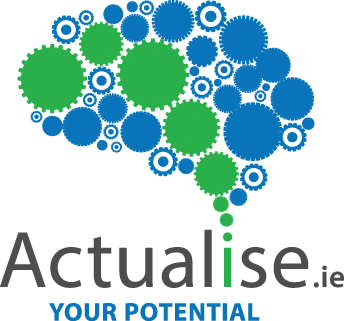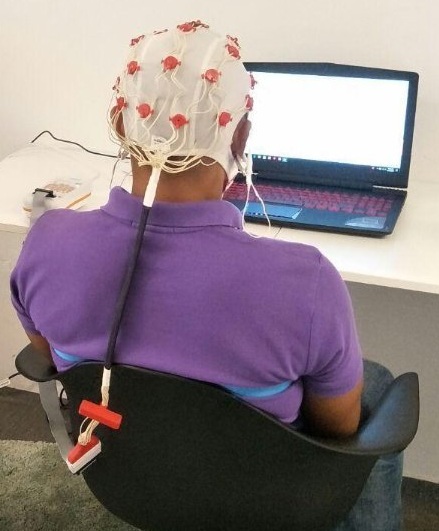Neurofeedback
We provide two neurofeedback options: remote and in-clinic. For more information on remote NFT, please read here. For in-clinic neurofeedback, we have partnered with The Dublin Mind Clinic. This is run by our wonderful colleague Michelle Franca who continues to consult with us at Actualise.
What is Neurofeedback?
Neurofeedback, or more precisely “Neurofeedback Training”, is a learning-based, completely non-invasive intervention that trains the brain to function more efficiently.
Several studies have extensively shown that Neurofeedback Training is particularly effective in the treatment of attention deficit and hyperactivity disorder (ADHD), anxiety, depression, low self-esteem, post-traumatic stress disorder (PTSD), anger management, substance abuse (addiction), and trauma.
However, Neurofeedback Training has also been shown to be a very powerful resource for those who don’t have any disorder in particular but still want to improve their performance at work and life in general (“Peak Performance” training).
How Does Neurofeedback Training Work?
The very first time a client visits the Neurofeedback clinic, an assessment of symptoms/complaints or personal development goals is performed by a certified Psychologist.
Subsequently, baseline (before Neurofeedback Training) electrical brain activity (electroencephalogram or EEG) is measured during a condition of complete rest (also called resting state).
Neurofeedback uses electroencephalogram (EEG) to measure and optimise your brain activity
This first phase is necessary to link behavioural reports and observations to brain function and, importantly, to identify areas of the brain that might not be functioning as well as they could.
For example, if you have had difficulties with attention, a specialist in EEG analysis will examine your resting state EEG tracings, looking for “anomalies” in the waveforms that are known to be associated with attention disturbances/disorders.
The EEG specialist will then select the areas of the brain associated with the EEG anomalies detected and finally devise a tailored Neurofeedback Training with a view to normalise abnormal EEG activity.
What Happens during a Neurofeedback Training session?
We have partnered with our colleagues at the Dublin Mind Clinic to provide neurofeedback training services.
As shown in the photo, you will be asked to wear a cap (very similar to a swimming cap!) with electrodes adhering to the head scalp to monitor electrical brain activity.
Importantly, the connection between electrodes and scalp is established in a completely non-invasive, pain-free way using water-based gel.
No injection or cut will be given to you at any stage of the session…all you will need at its completion is just a nice head wash with shampoo and warm water.
During the session, you will watch a movie on a computer monitor or engage in a computer game. Every time the selected brain regions exhibit EEG anomalies, the movie/game will stop.
While we measure your brain activity, a computer will give you real time feedback of your performance so you can quickly learn what works
However, the brain very quickly and gradually will learn to change its electrical activity in order to reduce the interruptions in movie/game reproduction and obtain a smoother perceptual experience.
In other words, session after session, by learning how to make the movie/game play more and more smoothly, your brain can learn to recruit new resources, eventually cancelling specific functional anomalies and ultimately reducing the associated behavioural disturbances.
CONTACT US: please fill out this form; we aim to get back to you within two working days.
References
1. Arns, M., H. Heinrich, and U. Strehl, Evaluation of neurofeedback in ADHD: the long and winding road. Biol Psychol, 2014. 95: p. 108-15.
2. Kubik, A., et al., [Clinical and neurophysiological data of neurofeedback therapy in children with ADHD]. Przegl Lek, 2016. 73(3): p. 148-51.
3. Janssen, T.W.P., et al., Learning curves of theta/beta neurofeedback in children with ADHD. Eur Child Adolesc Psychiatry, 2017. 26(5): p. 573-582.
4. Gonzalez-Castro, P., et al., Efficacy of Neurofeedback Versus Pharmacological Support in Subjects with ADHD. Appl Psychophysiol Biofeedback, 2016. 41(1): p. 17-25.
5. Mennella, R., E. Patron, and D. Palomba, Frontal alpha asymmetry neurofeedback for the reduction of negative affect and anxiety. Behav Res Ther, 2017. 92: p. 32-40.
6. Banerjee, S. and C. Argaez, in Neurofeedback and Biofeedback for Mood and Anxiety Disorders: A Review of Clinical Effectiveness and Guidelines. 2017: Ottawa (ON).
7. Linden, D.E., Neurofeedback and networks of depression. Dialogues Clin Neurosci, 2014. 16(1): p. 103-12.
8. Van der Kolk, B.A., et al., A Randomized Controlled Study of Neurofeedback for Chronic PTSD. PLoS One, 2016. 11(12): p. e0166752.
9. Markiewcz, R., The use of EEG Biofeedback/Neurofeedback in psychiatric rehabilitation. Psychiatr Pol, 2017. 51(6): p. 1095-1106.
10. Hanlon, C.A., et al., Reduction of cue-induced craving through realtime neurofeedback in nicotine users: the role of region of interest selection and multiple visits. Psychiatry Res, 2013. 213(1): p. 79-81.
11. Dehghani-Arani, F., R. Rostami, and H. Nadali, Neurofeedback training for opiate addiction: improvement of mental health and craving. Appl Psychophysiol Biofeedback, 2013. 38(2): p. 133-41.
12. May, G., et al., Neurofeedback and traumatic brain injury: a literature review. Ann Clin Psychiatry, 2013. 25(4): p. 289-96.



